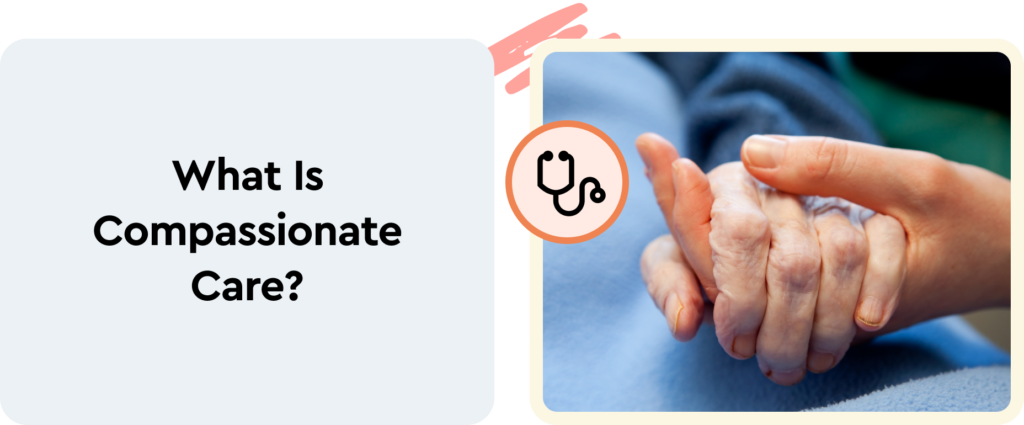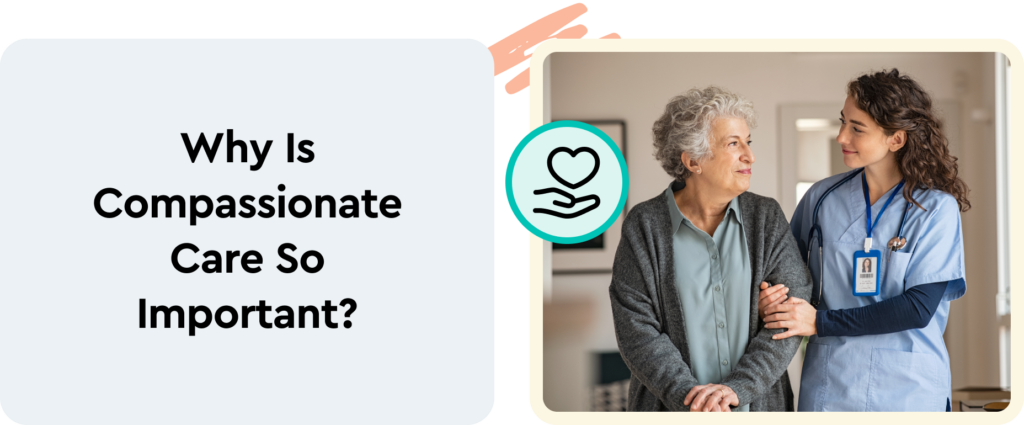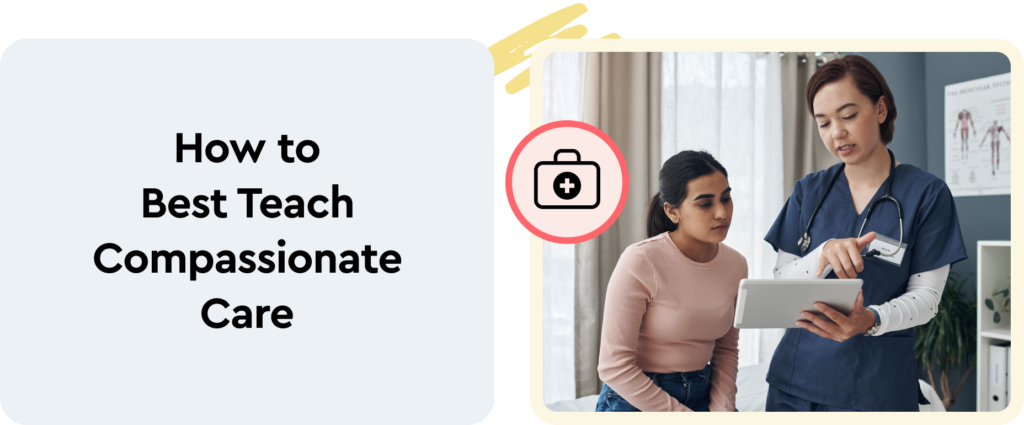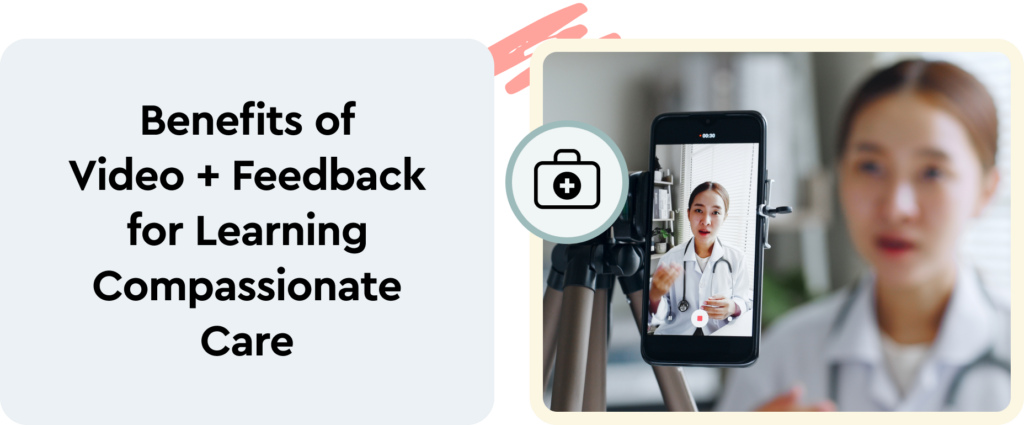In recent years, the focus of nurse education has shifted toward a competency-based model. This shift is reflected in the American Association of Colleges of Nursing’s (AACN) new Essentials: Core Competencies for Professional Nursing Education— which outlines the necessary curriculum content and expected competencies for graduates of bachelor’s, master’s, and Doctor of Nursing Practice programs.
To access a series of resources to help you implement the AACN Essentials. Check out our toolkit.
To prove competency in any of AACN’s Essential disciplines, nursing students must demonstrate correct skills. It’s no longer enough to pass written tests on theory and write essays that show understanding. Students today must physically demonstrate mastery of skills to become practice-ready.
Like communication, clinical judgment, and ethics, for example, compassionate care is included in AACN’s list of competencies. There is frequent overlap between many of the concepts included in the Essentials. For example, in order to effectively provide compassionate care, you must be able to effectively communicate. For associated tips on teaching and assessing communication competency, check out our ebook.

Today’s nursing curriculum must go beyond technical and theoretical aspects of patient care to address clinical compassion. Defining compassion might seem difficult, as people hold differing notions of what it entails. Merriam-Webster defines it as sympathetic awareness of another’s distress combined with a desire to alleviate it.
But being a nurse isn’t just about alleviating distress. It’s about putting yourself in your patient’s shoes, making them feel heard and seen, preserving their dignity, helping them to live as independently as possible, effectively communicating your genuine concern and understanding for their suffering, and doing everything you can—at a holistic level—to improve their circumstances. In sum, compassionate care is empathy in action.
Is It Bigger Than a Bread Box?
Perhaps even more challenging than defining compassionate care is measuring it. Identifying key characteristics of compassionate care makes its assessment a bit easier. Researchers at Edinburgh Napier University’s Leadership in Compassionate Care Programme (LCCP) found that patients and families value nurses who:
- Communicate with patients in a timely manner, especially upon arrival/admission
- Ask the right questions about the things that matter
- Take the time to develop a relationship with patients
- Are open and real about what the patient can expect
And the Schwartz Center for Compassionate Healthcare has identified these predictors of compassionate care:
- Striving to understand patients’ emotional needs
- Considering the effect of illnesses on patients and their families
- Listening attentively to patients
- Relaying information to patients in a simple, understandable terms
- Building trust
- Involving patients in decisions about treatment
- Comfortably discussing sensitive, emotional or psychological issues
- Treating patients as people, not just diseases or diagnoses
- Showing respect for patients and families
- Communicating test results to patients in a timely, sensitive manner
- Spending an adequate amount of time with patients
The Schwartz Center also identified “recognizing verbal and non-verbal cues” and “practicing self-reflection and emotion regulation” as part of its Compassionate Collaborative Care framework.

For starters, compassionate care is safer care. Thus, it is vitally important for patient well-being and the improvement of patient outcomes. Specifically, patient and family perceptions of providers’ compassion have been linked to:
- Increased immune responsiveness
- Long-term psychological adjustment after cancer diagnosis
- Better control and reduced hospitalizations for diabetic complications
- Decreased intensive care utilization at end of life
Compassionate care produces high patient satisfaction, which saves hospitals time and cost, and boosts the confidence, coping skills, satisfaction, and effectiveness of their staff. Uncompassionate care may result in hospitals and their staff receiving low ratings from patients and families, which can have a negative financial impact. In the U.S., funding for hospitals from the Centers for Medicare and Medicaid Services are tied to patient survey results.
Compassionate care is also important because it makes patients more comfortable when they’re experiencing pain or suffering. It gives them the support and confidence needed to recover more quickly and fully, face a scary surgery, or fight a formidable illness. And it can help to de-escalate some of the anxieties inherent in the patient experience.
Also worth noting is the finding that compassionate nurses typically enjoy their jobs more and feel more connected to their careers. Amid an unprecedented nursing shortage, retaining nurse talent is paramount.

The shift toward competency-based learning promoted by the AACN puts experiential learning (the process of learning by doing) at the forefront of nurse education. When students are engaged in hands-on experience and reflection, they are better able to connect theories and knowledge from classroom lectures and textbook study to real-world practice. Key benefits of experiential learning include:
- The ability to immediately apply knowledge
- Access to real-time coaching and feedback
- Promotion of teamwork and communication skills
- Development of reflective practice habits
- Personalization of learning
- Accelerated learning
In our post-COVID world, experiential learning is increasingly accomplished and evaluated using video assessment. The proven combination of video + feedback offered by GoReact provides a safe, effective, flexible, and cost-efficient way to help students bridge knowledge and practice.
Using video + feedback, instructors can model and record compassionate care in action. Students can study that video, then demonstrate and record their own skills practice. Then instructors/peers/students themselves can see and evaluate that video, sharing as needed.
Example Lesson in Compassionate Care
To assess students’ competency in compassionate care, instructors might record a video of themselves modeling the following scenario correctly and review it with students to identify specific examples of compassionate care.
Alternatively, instructors might provide students with the scenario text to study in advance, as an example of exhibiting many dimensions of compassionate care, and ask students to role-play and record the scene—exhibiting as many of the desired compassionate care steps as possible—for future observation, debriefing, sharing, feedback, self-reflection, and improvement.
Scene: Imagine you’re a nurse in a busy ER. Inside the exam room, a patient sits on the table and a patient care tech is busy filling supplies. The patient is a 50-year-old female with a bruise on her forehead and a black eye. She is crying. As the nurse, you enter the room. How can you exhibit compassionate care?
- Introduce yourself and shake hands with the patient, making eye contact.
- Ask the patient care tech to leave the room for patient privacy (promoting trust).
- Use a gentle tone. Speak slowly and clearly (do not rush) so the patient feels heard and important.
- Ask open-ended questions to elicit more information.
- Express concern for the patient’s injuries as well as her emotional state.
- Listen to what she says. Do not interrupt her.
- If the patient offers a description of the injury that doesn’t make sense, carefully probe a little to find out more.
- Ask the patient if she feels safe at home.
- Screen for depression/anxiety, and be sure to mention that you are required to do this with all patients.
- Offer to connect her with the hospital’s social worker for further assistance if needed, demonstrating care for the whole patient, not just her visible injuries.
- Ask if there’s anything else you can do to help.
- Set up a follow-up visit to check in on her status in a week or two.

- Recording video of a student skill demonstration captures an Indisputable, objective record of their performance.
- Videos can be viewed and evaluated synchronously or asynchronously.
- With GoReact, you have the ability to timestamp feedback to individually address specific actions.
- Instructors can provide audio or video feedback and model effective skills (for an entire team or one student) to explain or show what they could have done better.
- Students can view their video repeatedly, examine their own performance, and self-reflect.
- Students can see their own mistakes, which motivates them to improve, and see their successes, which builds confidence.
- Students can view and critique peers’ performance, promoting collaboration and improving their ability to give/receive feedback.
Learn more about the value and efficiency of using video observation for this lesson and others.
If you’re interested in learning more about video assessment to develop compassionate care and other Essential competencies among your students, request a GoReact demo today.











